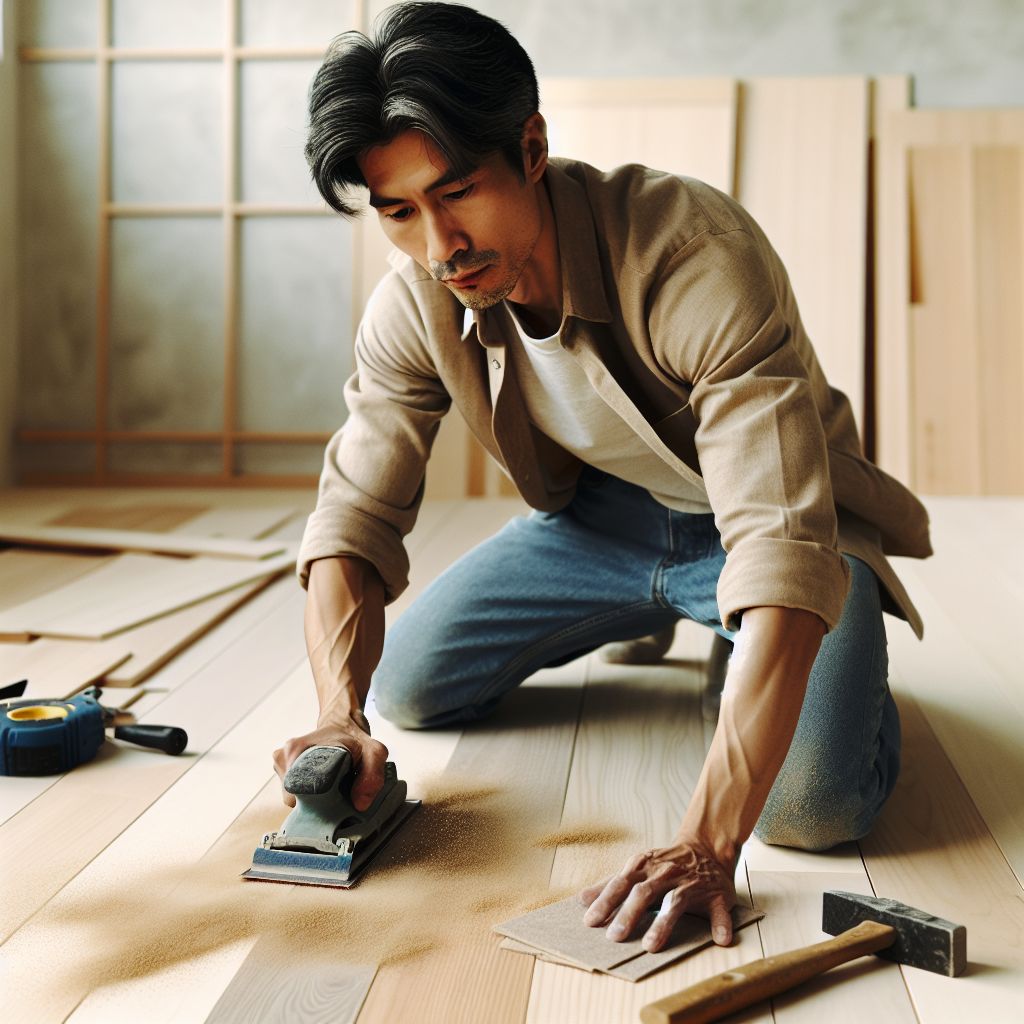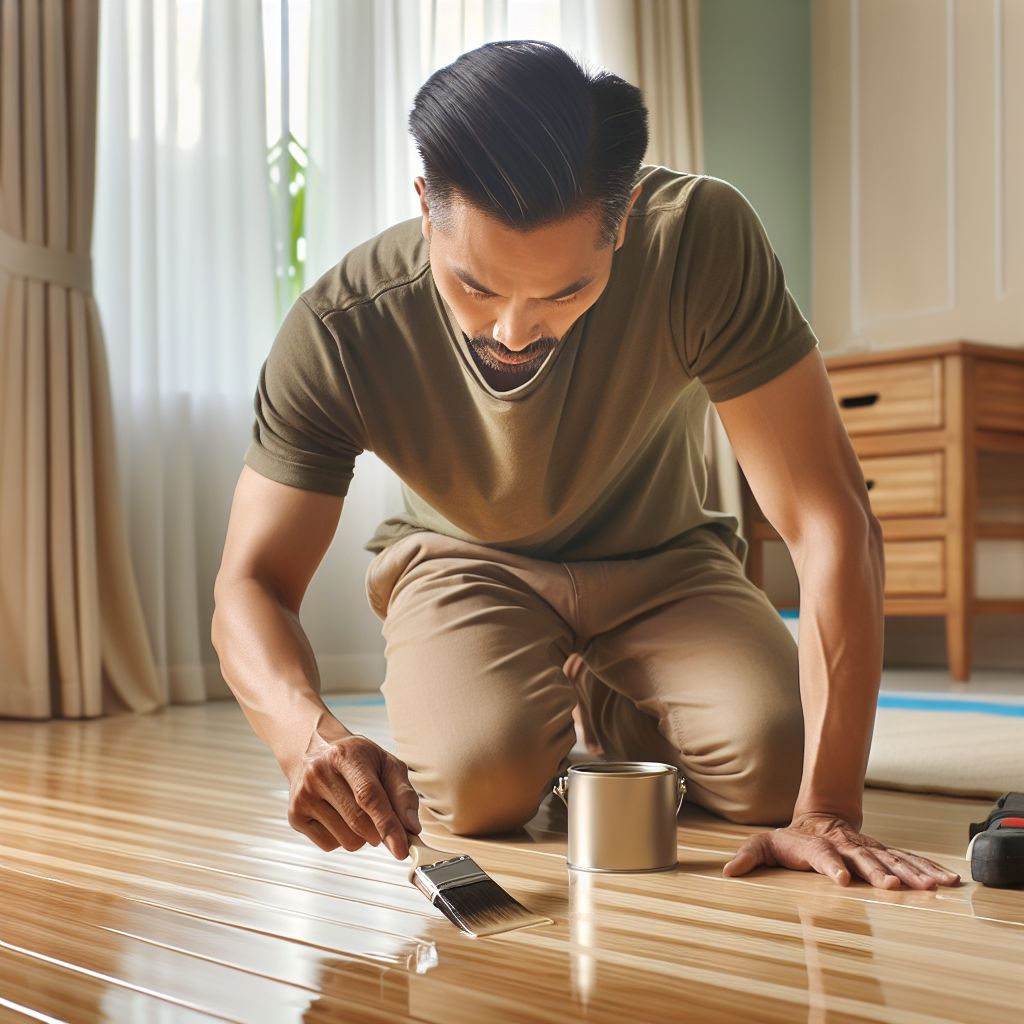
Key Takeaways
- Bamboo floors can be refinished by homeowners willing to invest time and effort.
- Essential tools include sanders, sandpaper, stains, and sealers.
- Proper assessment and preparation are critical to a successful refinishing job.
- Choosing the right type of sandpaper and sanding technique is vital for bamboo floors.
- Regular maintenance after refinishing extends the life and beauty of your floors.
Rejuvenate Your Bamboo Floors: A Do-It-Yourself Primer
Before you start, understand that refinishing bamboo floors is not just about aesthetics; it’s about preserving and protecting your investment. It’s a process that requires patience and precision, but the results are well worth it. You’ll transform a room, but you’ll also instill a sense of accomplishment that only comes from doing it yourself.
Gathering Your Tools and Materials
Success starts with having the right tools. Here’s what you’ll need:
- A drum sander and an edge sander – these can often be rented from local hardware stores.
- Various grits of sandpaper – starting from coarse (60-grit) to fine (100-grit or higher).
- A vacuum and tack cloth – for cleaning up dust between sanding and before finishing.
- Wood stain (if you’re changing the color) and a polyurethane sealer – to give your floors that new-floor shine.
- Paintbrushes or rollers – for applying the stain and sealer.
- Plastic sheeting and painters tape – to protect areas not being refinished.
- A respirator mask – because safety should never be compromised.
Remember, quality tools lead to quality results. Don’t skimp on these essentials.
Assessing Your Floors’ Condition
Before diving into the refinishing process, take a good look at your floors. Are there deep scratches or just surface scuffs? Is the current finish peeling or just dull? The extent of wear will determine how much sanding you’ll need to do. If your floors are fairly new and the damage is minimal, you might get away with a light sanding and a new topcoat. However, floors with deeper damage will require more intensive sanding.
Most importantly, consider the type of bamboo flooring you have. Engineered bamboo has a thin veneer that may not withstand heavy sanding. On the other hand, solid bamboo can be sanded down more aggressively. Knowing this will save you from potentially ruining your floors.

Prepping for Perfection: Before You Sand
Preparation is half the battle.
Cleaning and Clearing the Area
Start by removing all furniture and rugs from the room. You want a clean, clear space to work with. Next, thoroughly clean the floors. Any dirt or debris left behind can interfere with sanding and finishing.
Look out for any protruding nails or imperfections that could tear your sandpaper or damage the sander. If you find any, hammer them flat or pull them out.
Shielding Non-Work Spaces
Use your plastic sheeting to create a barrier between the work area and the rest of your home. Secure the sheeting with painters tape to ensure no gaps are left uncovered. This will contain the dust and debris, making cleanup much easier when you’re done.
Smooth Moves: Sanding Bamboo
This step is essential to get right.
Choosing Your Sandpaper Grit
When it comes to sanding your bamboo floors, the grit of the sandpaper you choose is critical. Start with a coarse 60-grit sandpaper to remove the old finish and any significant imperfections. Then, move up to an 80-grit sandpaper for smoothing out the surface. Finally, finish with a 100-grit or higher to achieve that ultra-smooth finish that’s essential for the stain and sealer to adhere properly.
The Right Way to Sand Bamboo
Sanding bamboo requires a gentle touch. Unlike traditional hardwoods, bamboo has a more delicate grain pattern that can be easily damaged by aggressive sanding. Use a drum sander for the main areas of the floor, moving with the grain of the bamboo, not against it. For the edges and corners, switch to an edge sander to avoid missing any spots. Always keep the sander moving to prevent gouging the floor, and periodically check your progress. You want to remove just enough of the surface to create a fresh, clean canvas for your new finish.

The Art of Staining Bamboo: Tips and Tricks
Staining your bamboo floors can give them a whole new look, but it’s an optional step. If you’re happy with the natural color of your bamboo, you can skip straight to sealing. If you do choose to stain, remember that bamboo is less porous than hardwoods, which affects how it absorbs the stain. This means you’ll need to be extra careful to apply the stain evenly to avoid blotchiness.
Testing Stain Colors
Before committing to a stain for your entire floor, it’s wise to test out a few colors. Find an out-of-sight spot on your floor or use an extra piece of bamboo flooring. Apply small patches of different stains and let them dry completely. This will give you a true sense of how each stain will look on your floors and under your home’s lighting. Once you’ve chosen your favorite, you’re ready to move forward.
Applying the Chosen Stain
Applying stain requires a steady hand and a bit of finesse. Work in manageable sections, using a brush or roller to apply the stain with the grain of the bamboo. Wipe away excess stain with a clean cloth as you go to prevent pooling or uneven coloring. After staining, wait for the recommended time for the stain to set before applying the sealer. This ensures the color is locked in and ready for the final protective layer.
Seal the Deal: Selecting and Applying the Finish
The finish is what protects your floors from everyday wear and tear, so choosing the right one is paramount.
Type of Finishes For Lasting Beauty
When selecting your finish, consider the following. Polyurethane finishes are popular for their durability and ease of application. They come in various sheens, from matte to high gloss, so you can choose the one that best suits your style.
- Water-based polyurethane is less toxic, dries faster, and has a clear finish.
- Oil-based polyurethane is more durable, has a warmer amber tint, and is better for high-traffic areas.
- Natural oil finishes penetrate the bamboo for a deeper protection but may require more maintenance.
Think about your household’s needs and choose a finish that will stand up to your lifestyle while enhancing the beauty of your floors.
Applying Finish Like a Pro
Applying the finish is the last step in the refinishing process. Use a high-quality brush or roller and apply the finish in thin, even coats. Follow the manufacturer’s instructions for drying times between coats. Usually, you’ll need at least two coats for even coverage. Be patient; rushing this step can lead to a finish that’s not as durable or attractive as it could be.

Maintaining Your Masterpiece: Post-Refinishing Care
After refinishing your bamboo floors, it’s important to adopt a careful maintenance routine to preserve their beauty and longevity. Proper post-refinishing care ensures the finish cures correctly and your floors stay in pristine condition.
Clean-Up and Curing Time
Carefully remove any tape and plastic sheeting, and give the room a thorough vacuum to pick up any lingering dust. Then, step back and give yourself a pat on the back.
After all your hard work, it’s important to take care of your newly refinished bamboo floors. Allow the finish to cure fully, which can take up to a week, before moving furniture back into the room. During this time, keep foot traffic to a minimum and avoid placing rugs on the floor, as they can trap moisture.
Long-Term Floor Care Strategies
After the hard work of refinishing, you’ll want to keep your bamboo floors looking stunning for as long as possible. Implementing a few strategic care routines can make all the difference.
Firstly, place felt pads under furniture legs to prevent scratches. Secondly, keep your floors dry; bamboo doesn’t take kindly to puddles. Thirdly, sweep or vacuum regularly to remove abrasive dirt and dust. Finally, use only cleaners specifically designed for bamboo floors to avoid damaging the finish.
Remember, the key to a successful DIY project is taking your time and following each step with care. With these tips and a bit of effort, your bamboo floors will look as good as new, and you’ll have the satisfaction of knowing you did it yourself.

Frequently Asked Questions
How Often Should Bamboo Floors Be Refinished?
The frequency of refinishing bamboo floors depends on the level of traffic and wear. On average, every 7-10 years is a good rule of thumb. However, if you notice significant scratches or the finish is dull and cleaning doesn’t restore the shine, it might be time to refinish.
Keep an eye on high-traffic areas; these may show signs of wear sooner. Consistent care and maintenance can extend the time between refinishing, so take care of your floors, and they’ll take care of you.
Can I Stain Bamboo Floors a Different Color?
Yes, bamboo floors can be stained a different color, but there are a few considerations to keep in mind. Bamboo differs from traditional hardwoods in grain pattern and density, which influences how it absorbs stain. To avoid unwanted surprises, always conduct a stain test on a spare piece of bamboo or in a hidden area of the floor to ensure the new color meets your expectations. This preliminary step will help you achieve the desired finish without compromising the look and quality of your flooring.
Staining is a great way to change the look of your floors, but it requires careful application to achieve an even finish. If you’re going for a drastic color change, it might be worth consulting with a professional to get the best results.
How Long Will the Refinishing Process Take?
The refinishing process for bamboo floors can take several days. Sanding and cleaning will likely take a day, depending on the size of the area. Staining and finishing each require a day for application and drying. In total, you should plan for at least 3-4 days from start to finish, not including the additional curing time for the final finish, which can be up to a week.
Is it Better to Hire a Professional or Refinish Floors Myself?
Deciding whether to hire a professional or DIY comes down to your comfort level with the tools and process. If you have the time, patience, and a bit of experience with home improvement projects, DIY refinishing can be a rewarding and cost-effective option. However, if you’re unsure about any part of the process, hiring a professional can ensure the job is done right and can save you from costly mistakes.
Can All Types of Bamboo Flooring Be Refinished?
Yes, all types of bamboo can be refinished but how many times and what type of equipment you need varies by type.
- Solid bamboo flooring can usually be refinished multiple times.
- Engineered bamboo flooring can be refinished, but the number of times is limited by the thickness of the veneer.
- Strand-woven bamboo is the hardest type of bamboo flooring and can also be refinished, but it may require specialized equipment due to its density.
It’s important to know what type of bamboo flooring you have before you begin. If you’re not sure, consult with a flooring professional or the manufacturer to get advice on refinishing your specific floors.





Leave a Reply